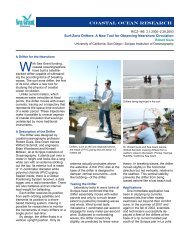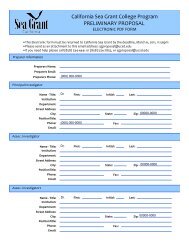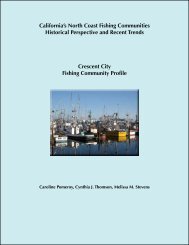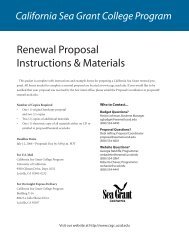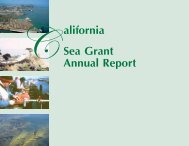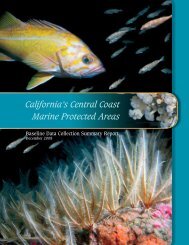PAT-UC Covers - California Sea Grant - UC San Diego
PAT-UC Covers - California Sea Grant - UC San Diego
PAT-UC Covers - California Sea Grant - UC San Diego
You also want an ePaper? Increase the reach of your titles
YUMPU automatically turns print PDFs into web optimized ePapers that Google loves.
Hedgecock’s analyses suggest that stocking, when used as a fishery management<br />
tool, is highly likely to erode genetic diversity of supplemented populations,<br />
particularly if it is successful at substantially increasing fish abundance. Somewhat<br />
paradoxically, however, hatchery releases can actually boost the genetic variability<br />
of small remnant populations, such as endangered salmon. Based on his findings,<br />
Hedgecock has recommended that, as a matter of course, hatcheries should tag all<br />
fish and document their parentage before releasing them so that their interactions<br />
with wild fish can be evaluated through time.<br />
Strange Disease at Hatchery Explained<br />
With <strong>Sea</strong> <strong>Grant</strong> funding, fish pathologist Ronald Hedrick of <strong>UC</strong> Davis was able<br />
to determine the cause of a disease at the state’s white seabass hatchery that led<br />
to the destruction of thousands of fish: a rickettsial pathogen called Piscirickettsia<br />
salmonis, infamous for plaguing salmon farms. Before this <strong>Sea</strong> <strong>Grant</strong> research, the<br />
consensus within the scientific community was that P. salmonis could infect only<br />
salmon, hence the pathogen’s Latin name.<br />
The pedigree is also being used to<br />
investigate whether sturgeon can be<br />
selectively bred for superior caviar weight,<br />
grade, color, firmness and yield. If so,<br />
the industry’s value would stand to rise<br />
significantly, particularly given the status of<br />
wild sturgeon populations and severe caviar<br />
shortages from the Caspian <strong>Sea</strong> region.<br />
These conditions, and sky-high prices for<br />
specialty caviars like beluga, are fostering<br />
greater consumer acceptance of cultured<br />
products (see project R/A-109).<br />
Genetic Ramifications of Stock<br />
Enhancement<br />
With many fisheries in decline, state<br />
resource agencies are considering stocking<br />
as a way to replenish depleted populations.<br />
There are, however, concerns that this<br />
practice could reduce genetic variability,<br />
and hence the fitness of wild fish. <strong>Sea</strong> <strong>Grant</strong><br />
funded geneticist Dennis Hedgecock of<br />
<strong>UC</strong> Davis to calculate the “effective size” of<br />
the broodstock at the state’s white seabass<br />
hatchery, which releases tens of thousands<br />
of fish each year.<br />
Subsequent <strong>Sea</strong> <strong>Grant</strong>-funded experiments by Hedrick have shown that P.<br />
salmonis can indeed be transmitted between salmon and white seabass. Among<br />
other things, this finding highlights the potential for farms to infect wild fish and<br />
vice versa. Because of Hedrick’s research, the hatchery now tests juvenile seabass<br />
for P. salmonis before releasing them, a procedure that dramatically reduces the<br />
chances of spreading disease.<br />
The molecular tools advanced in this project, including the development of an<br />
early detection test, can easily be adapted for large-scale commercial use. A vaccine<br />
for the disease is currently under development, and Hedrick’s work has received<br />
widespread media attention.<br />
Migrating <strong>California</strong> Salmon (Photo USFWS)<br />
19<br />
<strong>California</strong> <strong>Sea</strong> <strong>Grant</strong>: 1998-2003



